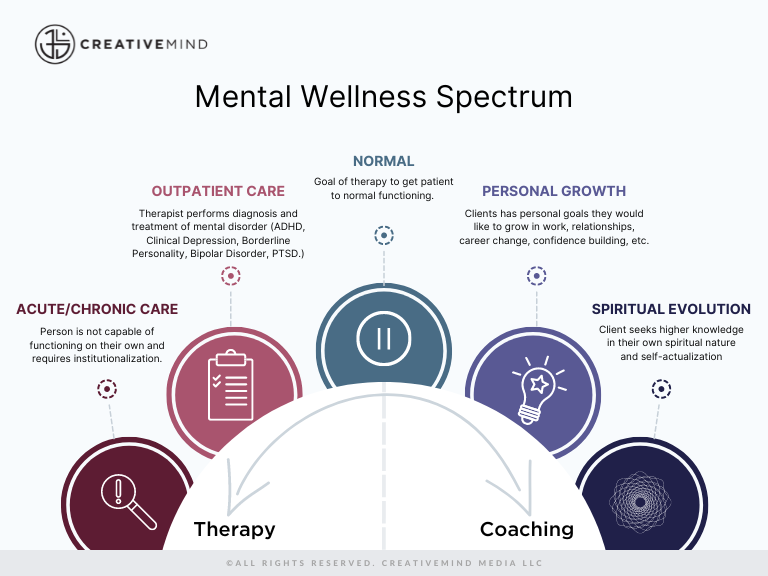Our clients and students often ask about the difference between therapy and coaching.
The truth is there’s a whole spectrum of mental wellness that comes into play when answering this question. It isn’t black and white. We must take a more holistic view of all the possibilities to get a clear picture.
So let’s break down the mental wellness spectrum.

Normal
In the middle of the spectrum is what we call “normal.” It is important to acknowledge that the definition of normal is absolutely relative (and none of us are really “normal”). In the context of the Mental Wellness Spectrum, we mean that a person is functioning — they’re able to work, they don’t have a lot of symptoms or anxiety and they’re doing okay dealing with life.
Operating at normal is the baseline of living. It doesn’t mean a person is perfectly healthy and has maxed out on growth, but that they can function and don’t need treatment.
Outpatient Care
Now let’s look at therapeutic levels of treatment. Just below normal on the spectrum is outpatient care, or, therapy. Therapy can be helpful for people suffering from things like clinical depression, personality disorders or unresolved trauma. The goal of therapy is to reach normal functioning.
Typically, a therapist performs a diagnosis and treats the mental disorder showing up in the patient. A medical model is used for diagnosing and treating a disorder and may include prescribing medication.
Acute/ Chronic Care
If a person cannot function independently, they require acute/ chronic care or institutionalization.
Even though this is the far end of the spectrum, patients in acute care can make their way to normal functioning and beyond. Eventually, some acute care patients can function in the world on their own with the help of outpatient care and strive for “normal.”
Personal Growth
On the other side of the spectrum just beyond normal, we have personal growth. This is where coaching comes into play. Since coaches cannot diagnose or treat mental disorders, they work with normal-functioning clients who want to reach their full potential. Clients may wish to work on personal goals like career transitions, relationship struggles, confidence building or wealth mindset.
A coach helps their clients reach their full potential by empowering and guiding them to break through barriers to change and resistance.
Spiritual Evolution
Further on the coaching side of the spectrum is spiritual evolution. The type of person seeking higher knowledge, an understanding of their spiritual nature and self-actualization would fall into this category.
Certain coaches, like Jungian Life Coaches, can help clients in their spiritual evolution. Psychologist Carl Jung coined the term Individuation as a path to self-actualization. Jungian Life Coach Training with CreativeMind takes students on the path of individuation, helping them transform their lives on a deeper level.
The Difference Between Therapy and Coaching
One of the biggest differences is that therapy requires a license and a Master’s degree or higher to practice. A therapist can only practice in the state or area their license permits since every state has different laws and regulations.
Coaching is an unregulated industry which has its caveats. To help set a standard in the coaching industry are organizations like the International Coaching Federation (ICF) and the National Board for Health and Wellness Coaching (NBHWC). Coach training programs accredited by ICF and NBHWC adhere to a standard of education, experience and ethical requirements. A coach does not need a certain degree of education and can work with anyone in the world.
Therapy and Coaching industries serve two different sets of people and cater to different stages of human development. Most people fall into outpatient care and personal growth on the mental wellness spectrum, so there are many opportunities for both industries. Depending on the symptoms a person experiences, they will go to a therapist to be diagnosed and treated, or they will go to a coach to achieve goals and become a better version of themselves.
Understanding the mental wellness spectrum can help people choose the right service provider for their needs. It’s important to know that we are not limited to one level on the spectrum. For example, if you seek outpatient care for an aspect of your life, you can simultaneously pursue personal growth and spiritual evolution.
We all have the ability to reach our full potential.
Ready to start your coaching career?
Become a certified Jungian Life Coach with CreativeMind. Download your free course brochure and let your coaching journey begin!


